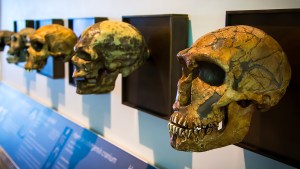Lenten Campaign 2025
This content is free of charge, as are all our articles.
Support us with a donation that is tax-deductible and enable us to continue to reach millions of readers.
Archaeologists may have just identified the first evidence of Down syndrome among the prehistoric Neanderthal population. If accurate, the findings suggest that the Neanderthals may have cared for their weakest members in much the same way that Homo sapiens do, which was previously thought to be a distinctly Homo sapiens trait.
According to El Pais, the study focused on a fossilized bone fragment no bigger than a thumb that was found in the 1980s in Cova Negra, in Spain. The bone was determined to have belonged to a six-year-old child (gender unidentified) who most likely lived between 270,000 and 146,000 years ago. The bone in question was identified as a petrosal — a dense cranial bone located behind the ears – but a computer analysis has revealed congenital malformations that are often associated with Down syndrome.
A child in need of care
Researchers surmised that the malformations would have left the child deaf with very little balance control. Furthermore, they believe that the child would not have been able to survive until age six without care from his mother and others in the community. The findings have brought new light to a decades-old debate as to whether or not other human species were capable of such altruistic behavior; caring for the sick without any recompense.
This is the first instance in which a Neanderthal suspected to have Down syndrome has been discovered. Juan Luis Arsuaga, co-director of the Atapuerca archaeological site and co-author of the study, commented that the findings show that Down syndrome has existed throughout human history. He also noted that the evidence found in Cova Negra suggest that the Neanderthals did care for their families:
“Neanderthals greatly appreciated their children, and we know this precisely because many children’s remains have been found in Cova Negra that we think received burials.”
Just the latest in a series of stunning discoveries
The discovery is just the latest example of how our understanding of human origins and development has been challenged in recent decades. For example, in 2003, researchers on the Indonesian island of Flores discovered the remains of Homo floresiensis, a diminutive form of archaic human nicknamed “hobbits” by their discoverers. In 2013, bones of another archaic human species called Homo naledi were found in South Africa, along with evidence (disputed by some scholars) that they may have buried their dead — hundreds of thousands of years ago.

Then in 2023, archaeologists published a paper in Nature that stunned the scientific community with news that they had discovered a pair of notched logs at Kalambo Falls, Zambia that were 476,000 years old. This would indicate that archaic humans were utilizing wooden structures almost half a million years ago. Findings like this demonstrate how the story of human evolution and development remains complex and, in many ways, deeply mysterious.
Read more comments from the latest study’s authors at El Pais.



